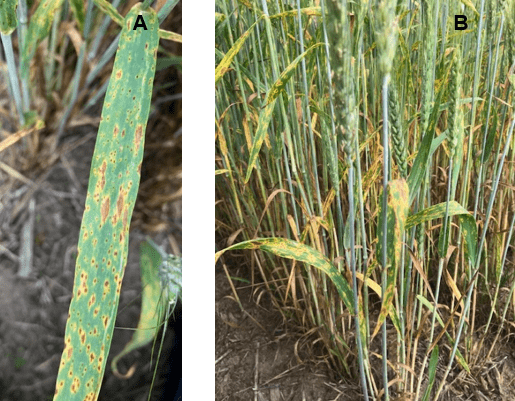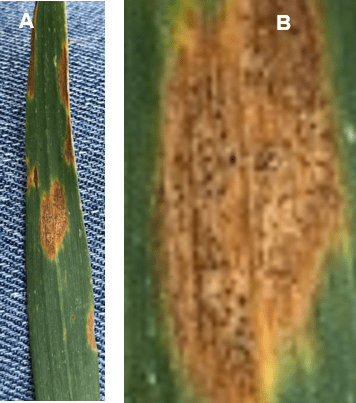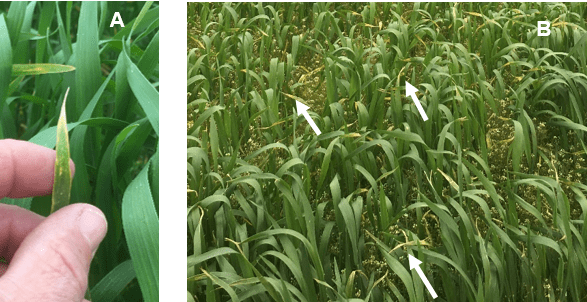Nidhi Rawat, Small Grains Pathologist
University of Maryland, College Park
With low temperatures and intermittent showers, this wheat season has been unusual in Maryland. The cool wet season was conducive to the growth of several foliar fungal pathogens. At the same time, several physiological issues caused by the unusual weather conditions manifested themselves on leaves of the plants. The conditions were not too supportive for extensive symptom development for Fusarium Head Blight so far, although DON contents should be analyzed before declaring it a FHB-free year. The major diseases/ physiological disorders observed in the state this year so far are described below to help in identification of the underlying factors.
Leaf Diseases
Tan Spot
The fungal pathogen, Pyrenophora tritici-repentis, produces host-selective toxins that causes yellowing and death of leaf tissue. Symptoms of tan spot early in the season include diamond-shaped or oval spots with a yellow halo mostly on the lower leaves. These spots turn brown and progressively enlarge and coalesce damaging large areas of leaf tissue. These tan colored spots have a small dark brown center resembling an “eye-spot” that is particularly distinctive when holding the leaf up to the sunlight (Fig 1). Tan spot may develop any time during the growing season, but well-developed lesions are frequently observed later in the season. After the season is over, the fungus overwinters in straw and stubble as black fruiting bodies called pseudothecia.

Septoria/Stagonospora nodorum Blotch (SNB)
The causal agent of SNB is the fungus Parastagonospora nodorum. Symptoms usually appear after head emergence and are mostly found on the upper leaves, although all leaves are susceptible. SNB starts as small, water soaked dark brown flecks, which later expand to make larger irregular dark brown lesions (Fig 2). As the disease progresses, the lesions develop an ash gray-brown center containing brown-black pepper grains (pycnidia), which are sometimes difficult to see in brown lesions. Glume blotch, which refers to the SNB on glumes of wheat heads, is caused by the same pathogen (Fig 2). Pycnidia, which are brownish-black pepper grain-like dots, are the asexual reproductive structure of the fungus and are diagnostic of this disease.

Septoria tritici blotch (STB)
STB is caused by fungus Zymoseptoria tritici (previously named Septoria tritici). Symptoms of STB are usually detected on lower leaves in the fall and early spring as yellowish or chlorotic flecks on leaves. Symptoms start as yellowish flecks, especially on the lower leaves, which are in contact with the soil. These flecks enlarge and develop into brown to reddish brown lesions, which are initially restricted to the leaf veins, giving the appearance of parallel sides. More importantly, lesions are associated with the presence of visible pycnidia that are sphere or ball-shaped, gelatinous and gray-brown. These small black pycnidia in lesions are the most reliable in-field characteristic for identifying SNB. Differentiating STB from SNB can be difficult and often requires microscopic observations.

Barley Yellow Dwarf (BYDV)
BYDV is a viral disease caused by a Luteovirus transmitted by aphids. The typical symptom of BYDV, as the name suggests, is yellowing of leaves that starts from the tip and progresses towards the base (Fig 4). The yellow color changes to purple and red as disease develops. Severe infection leads to stunting of plants. Oftentimes the flag leaves of infected plant stand out prominently as a reddish flags. The symptoms of BYDV may often be confused with nutrient deficiency or leaf streak mosaic virus. The disease occurs in patches in the field indicating the area of infestation by aphids, as compared to mineral deficiency, which is present more or less uniformly in the field. Aphid vectors may be visible on the plants infected with BYDV. Unlike leaf streak mosaic virus, BYDV does not have a distinct mosaic pattern on the leaves. Definitive confirmation of BYDV can be done by lab tests.

Physiological Disorders
Leaf Tip Necrosis
Leaf tip necrosis (LTN) is a physiological disorder and can be caused by several factors namely: hot dry air, contact fungicides, foliar fertilizer burn, soil salinity, cool evening temperatures. Even some genetic factors such as leaf rust resistance gene Lr34 or stripe rust resistance gene Yr18 are known to cause leaf tip necrosis. LTN normally progresses from the margins of the flag leaf tip and lower leaves should show some signs of it as well (Fig 5). The severity of the leaf tip necrosis is dependent on both the variety and the growing conditions during flag leaf emergence and early grain-fill and thus some varieties have a tendency to show a lot more leaf tip necrosis than others.

Physiological Leaf Spotting (PLS)
Physiological leaf spotting (PLS) is another issue that we observed this season. There are majorly two factors/ triggers that may cause PLS, namely: chloride deficiency and tissue oxidation due to sun damage. PLS is bit of a black box when it comes to diagnosing or predicting when it will appear. Chloride is an essential micronutrient for plants, and is generally not tested for in tissues or soils. In case of sun damage, spotting occurs after a period of prolonged cloudy weather that is then followed by sunny weather. Such symptoms appear first, and more uniformly, on upper leaves exposed to direct sunlight and little is seen further down in the canopy; but in severe cases lower canopy leaves can express symptoms as well. PLS may be mistaken for spotting caused by the previously described diseases. However, the pattern of distribution of symptoms is more uniform and spread over to a larger geographical area than the diseases. Unfortunately, there is no ‘test’ that can be done to confirm this type of PLS; only the elimination of all other possible causes.

Management of Wheat Foliar Fungal Diseases
It is important to diagnose the correct underlying disease/physiological factor of a disorder in order to make productive management decisions. Following are some of the management strategies that are helpful in the cases of the diseases described above.
- Disease prevention by growing resistant varieties is the most economical method of control of fungal foliar diseases. Varieties with a good resistance level may be available for some of these diseases, for others a moderate to low level of resistance may be available.
- Good-quality and pathogen-free seed should be used for planting. Planting seed infested with these fungal leaf spot pathogens can result in reduced germination and poor seedling vigor.
- Seed treatment fungicides can reduce the risk of seedling infections.
- Crop rotations can reduce the initial inoculum load of fungal leaf spots.
- Management of volunteer weeds that serve as green-bridge for these diseases from one year to the next is helpful.
- Several fungicides are labeled for the management of tan spot and the Septoria complex. Early season fungicide application is not recommended in the absence of disease or in an unfavorable environment. A good source of information is the fungicide efficacy table organized by the North Central Regional Committee on Management of Small Grain Diseases (NCERA-184) and can be found on the UMD Plant Sciences/Extension website.
